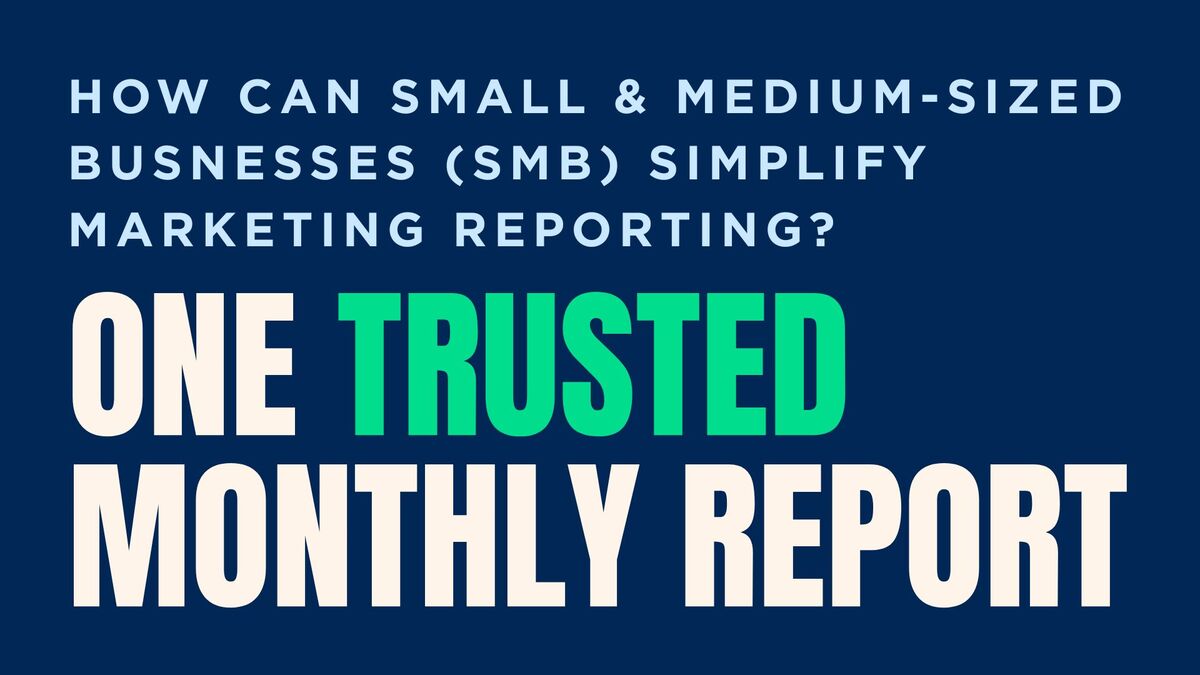blog
How Can Small and Medium-Sized Businesses (SMB) Simplify Marketing Reporting? One Trusted Monthly Report
How Can Small and Medium-Sized Businesses (SMB) Simplify Marketing Reporting? One Trusted Monthly Report

Are you heading into a new quarter or board meeting without a page you trust? If you run growth for a small- or mid-sized business, you are likely juggling GA4, Looker Studio, and HubSpot, plus a spreadsheet, while everyone asks for one page.
Most teams assume current dashboards will work. In reality, GA4 events and conversions are half set, Looker Studio blends are fragile, and HubSpot definitions do not match.
Leadership asks for one page, and the team sends three links. Confidence drops. The stakes are real. Budget talks get harder, pipeline health is unclear, and marketing looks like activity instead of impact.
You don’t need a rebuild or a data engineer. Choose a primary view for your goal, connect core data once, and package it into a monthly page your team can maintain.
This guide explains what GA4, Looker Studio, and HubSpot each do best by goal. It shows exactly what to include on the page, plus a light setup checklist and common traps to avoid.
Who Should Use an SMB Reporting Guide?
If you are the person who gets asked, “Can you put this on one page?” This guide is for you. You do not need a data team or a rebuild. You need a clear primary view, connected once, and a monthly page you can deliver every time.

Busy Marketing Leaders at Small and Mid-Sized Companies
You need one trusted monthly view of performance leadership will actually read. That means a single place to view key performance indicators (KPIs) tied to pipeline and revenue, with simple definitions your team can maintain.
We will show you how to set it up in a way your team can keep current without late-night spreadsheet work.
Why SMB Marketing Dashboards Fail and How to Fix Them
Most dashboards fail for a simple reason: they try to do everything. When each tool tells a slightly different story, confidence drops and decisions stall. The cure is not more data. It is a better frame and a lighter, steadier process.
Why Dashboards Are Not Trusted
Leaders stop trusting dashboards when they see activity without impact. Half-set GA4 events, fragile Looker Studio blends, and mismatched HubSpot definitions produce three links and zero answers. Without shared definitions and a single monthly page, everyone argues about the numbers instead of acting on them.
The Fix for Reliable Monthly Reporting
Pick one primary platform that matches your goal. Connect core data once. Standardize a few metric definitions, not dozens. Then deliver a single monthly page that answers: Are we on target? What moved the pipeline? What is our efficiency? What will we do next? When this page is delivered reliably, confidence returns, and budget conversations get easier.
The Common Gap You Need to Close
Inconsistent tracking, loose naming, and no set review cadence cause issues. Close that gap with a small habit stack: weekly data checks, fixed UTM standards, and a 30-minute month-end readout that ends in clear decisions.

How To Choose the Right Reporting Platform
Before you build a new dashboard, answer three questions. What is the primary goal? Which sources do we need? Who will use it each month? Your answers determine the home base for your reporting and keep you from overbuilding.
Decision Criteria for SMB Marketing Reporting
- Primary goal: Are you proving pipeline growth, understanding web and content performance, or giving executives a cross-channel snapshot.
- Required data sources and users: List the sources, such as site analytics, CRM, and ad platforms, and who reads the page, including CEO, finance, sales, and marketing. Build to the lightest common need.
- Build effort and maintenance: Choose the option your team can keep clean monthly. A good and delivered page beats a complex system that decays.
Objection check: “We already have dashboards.” Great. Keep them for deep dives. Your monthly page is the front door, not a replacement.
Quick Platform Recommendations by Goal
- Lead lifecycle and attribution → HubSpot. Best when leadership wants to see contacts, lifecycle movement, opportunities, and revenue tied to sources.
- Web and content performance → Google Analytics with GA4. Best for sessions, engagement, conversion paths, and content that moved people to act.
- Cross-channel executive view → Looker Studio. Best when you need an at-a-glance blend of KPIs from multiple tools on one page.
Platform Guides for Google Analytics GA4, Looker Studio, and HubSpot
Use each platform for what it does best. You will avoid fragile setups and reduce the number of places leaders need to click.
Google Analytics (GA4) Reporting Essentials
Best for: Web and content insights with event-based tracking.
Include on your page: Sessions, engaged sessions, conversion rate, top sources and mediums, and top pages that lead to conversions.
Watch for: Event setup quality, attribution settings that match your sales cycle, and cross-domain consistency for forms, subdomains, or checkout flows.
Time concern: “We don’t have time to rebuild tracking.” You don’t need to. Start with 5 to 7 critical events and name them clearly. Expand later.
Looker Studio Reporting Essentials
Best for: Blending multiple sources into one executive view.
Include on your page: High level KPIs with goal versus actual, channel and source breakdowns, and simple progress bars to target.
Watch for: Connector limits, data freshness windows, and fragile blends. Keep blends minimal. Prefer calculated fields and standardized naming over complex joins.
HubSpot Reporting Essentials
Best for: Contacts, deals, lifecycle stages, and revenue attribution.
Include on your page: New contacts, MQLs, SQLs, opportunities created, pipeline added, and revenue closed. Pair each with clear source attribution.
Watch for: Duplicate records, lifecycle stage rules, and model alignment. Decide on first touch, last touch, or multi-touch.
Document your choice once and stick to it.
What To Include on One Monthly Report Everyone Trusts
This page should be readable in five minutes and actionable in thirty. Keep it to four sections and end with the next steps.
Executive Summary KPIs
Open with one revenue goal and two marketing KPIs that matter this month. Show target and variance. Beneath them, write three takeaways, including what changed and why, and what you will start, stop, or scale next month.
If your CEO only wants revenue on one page, lead with it and keep the supporting KPIs tight.
Pipeline And Revenue View
Show opportunities created and revenue closed by source, so leadership sees what truly feeds the business. Add win rate and sales cycle length with month-over-month change. This turns marketing activity into sales impact and anchors budget talks in outcomes, not clicks.
Cost And Efficiency Metrics
List spending by channel and cost per result, such as cost per MQL, cost per opportunity, or cost per order. Add return on ad spend or pipeline per dollar to tie investment to value. Keep the metric names consistent with finance to avoid translation debates.
Data Hygiene and Cadence
Close with the maintenance that keeps trust high. Confirm UTM standards for source, medium, and campaign. Include a short glossary for key metrics.
Note your weekly data checks for connectors and anomalies and the month-end review date. This section is the guardrail that prevents decay.
Light setup checklist:
- Pick your primary platform: GA4, HubSpot, or Looker Studio
- Define 5 to 7 core metrics and their formulas
- Standardize UTMs and naming
- Connect core sources once
- Schedule a recurring month-end
- Readout with owners and next actions
Partner With Legend to Launch Your Monthly Reporting Page
Your reporting process should give leaders clarity without adding extra work to your plate. At Legend, we focus on making data accessible, consistent, and easy to act on. Contact us today to learn more about how we simplify monthly reporting and support your team’s goals. We’ll walk you through what we do and how it can fit your needs.

